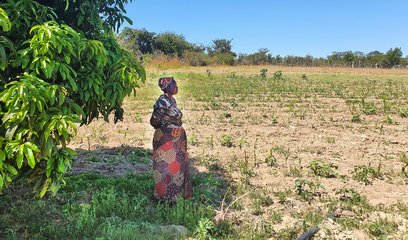-
9.8 million
9.8 million people affected by drought
-
25 %
25% of children under five suffer from food poverty
From one extreme to the next: "It's either too wet or too dry, we hardly have any normal weather," says maize farmer Buumba. This puts many people in Zambia in a desperate situation, as more than half of the country's population is reliant on agriculture.
Extreme weather endangers millions of livelihoods. In 2024, Zambia experienced one of the worst periods of drought in over 40 years, which was due to the consequences of of the El Niño weather phenomenon and the relentless effects of the climate crisis. 9.8 million people were affected by the drought.
Loss of livestock, poor harvest
Heavy rainfall at the beginning of 2024 was followed by a prolonged dry period. This led to an electricity crisis because the power supply is dependent on hydroelectric power plants. Many households and businesses were left without electricity for days.
Springs dried up in rural areas. Livestock died on withered pastures. The total harvest was 43 percent below the five-year average. Corn, the most important staple food, was particularly affected. Almost five million people did not have enough to eat.
Women and children go hungry
As in many crises, women and children have been hit particularly hard: a quarter of children under five suffer from food poverty. They often only have one simple meal a day.
Pregnant and breastfeeding women also frequently suffer from malnutrition. "The situation is catastrophic and continues to deteriorate, especially for women and girls," says Chikwe Mbweeda, CARE Country Director in Zambia. "They have to walk long distances to fetch water. This puts them at risk of violence. The water is usually not clean and increases the risk of disease."
CARE in Zambia
CARE has been active in Zambia since 1992, working with local, national and women-led partner organisations. The determination and strength of these community leaders to face their challenges together is remarkable.
The focus is on long-term, community-based projects with the aim of mitigating climate-related challenges, promoting sustainable development and bringing about social change. Project participants are trained in new cultivation methods, supported with reforestation and provided with drought-resistant seeds.
CARE is working the Choma District Women Development Association (CDWDA) to tackle the drought crisis. The CDWDA promotes the empowerment of women through capacity building and market networking. In consultation with the local government, the CDWDA supported around 5,000 affected people (mainly women and elderly people) in the Choma district to receive protection and food aid.
Ten forgotten crises
The CARE Crisis Report is published annually and highlights the ten crises that receive the least media attention. In 2024 Zambia ranked as the ninth least reported crisis in the world.
